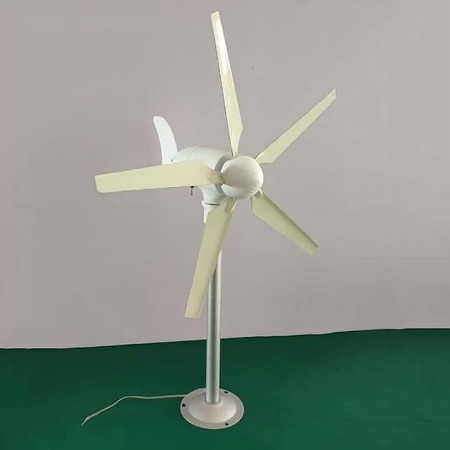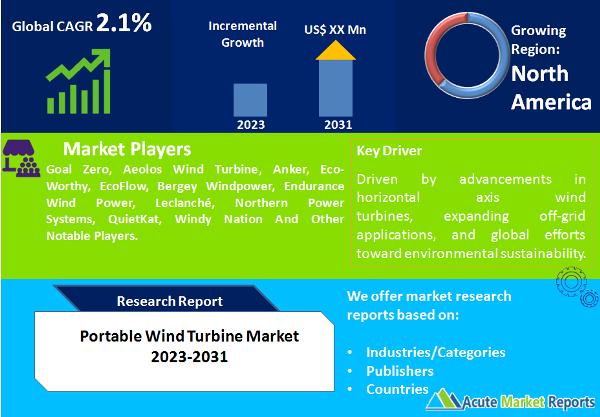
Portable wind turbine market is at the forefront of sustainable energy solutions, offering a promising alternative to traditional power sources. The portable wind turbine market is expected to grow at a CAGR of 2.1% during the forecast period of 2025 to 2033, driven by advancements in horizontal axis wind turbines, expanding off-grid applications, and global efforts toward environmental sustainability. While wind intermittency remains a challenge, innovations in design and technology are mitigating its impact. Market segmentation by axis type and application underscores the market's dynamics, while geographic trends reveal regional variations in demand. Competitive players are actively engaged in innovation and market expansion to meet the growing demand for portable wind turbines. The portable wind turbine market is poised to play a vital role in the transition to sustainable energy sources and the reduction of carbon emissions.

Advancements in Horizontal-Axis Wind Turbines
One of the principal drivers propelling the portable wind turbine market is the continuous advancement in Horizontal Axis Wind Turbines. These turbines are increasingly efficient, compact, and easier to transport. They have a proven track record of harnessing wind energy more effectively and converting it into electricity. The innovations in blade design, materials, and the introduction of smart technologies have significantly boosted the adoption of Horizontal Axis Wind Turbines.
Increasing Off-grid Applications
The portable wind turbine market has been significantly driven by the growing applications of off-grid power sources. Portable wind turbines are ideally suited for off-grid scenarios, such as outdoor recreational activities, remote industrial sites, and disaster-stricken areas where conventional power sources are unavailable or impractical. The ability to generate clean energy in off-grid locations is a powerful driver for portable wind turbines.
Environmental Sustainability and Renewable Energy Goals
A growing global emphasis on environmental sustainability and the pursuit of renewable energy goals have become key drivers for the portable wind turbine market. Governments, organizations, and individuals are increasingly recognizing the importance of transitioning to clean energy sources to reduce greenhouse gas emissions and combat climate change. Portable wind turbines align with these sustainability goals and offer an accessible and renewable energy solution.
Restraint in the portable wind turbine market
A primary constraint in the portable wind turbine market is the intermittent nature of wind as an energy source. Wind availability varies with weather conditions, time of day, and geographical location. This intermittency can pose challenges for meeting continuous power demands, especially in off-grid applications where energy storage solutions are limited.
Market Segmentation by Axis Type (Horizontal Axis Wind Turbine, Vertical Axis Wind Turbine): Horizontal Axis Wind Turbine Dominates the Market
The portable wind turbine market can be segmented based on axis type, which includes Horizontal Axis Wind Turbines and Vertical Axis Wind Turbines. In 2024, "Horizontal Axis Wind Turbine" accounted for the highest revenue. The dominance of horizontal-axis wind turbines is attributed to their efficiency and widespread use. For the forecast period from 2025 to 2033, "Horizontal Axis Wind Turbine" is expected to maintain its lead with the highest compound annual growth rate (CAGR). Innovations in design and technology continue to drive the market's growth in this segment.
Market Segmentation by Application (On-grid, Off-grid): On-grid Applications Dominate the Market
The portable wind turbine market is further segmented by application into "On-grid" and "Off-grid." In 2024, "On-grid" applications generated the highest revenue, primarily due to their contribution to the traditional power grid. For the period from 2025 to 2033, "Off-grid" applications are projected to have the highest CAGR. The demand for portable wind turbines in off-grid applications is expected to grow significantly due to their capability to provide power in remote locations and emergency situations.
Geographic Segment (Geographic Trends, Region with Highest CAGR, Region with Highest Revenue Percentage): APAC to Remain as the Fastest Growing Market
The portable wind turbine market exhibits diverse geographic trends, with some regions leading in both revenue percentage and CAGR, while others have high revenue percentages. Geographic trends show that North America and Europe have been prominent markets for portable wind turbines, driven by early adoption, environmental awareness, and government incentives. However, the Asia-Pacific region, especially countries like China and India, is expected to experience the highest CAGR during the forecast period of 2025 to 2033, primarily due to increasing power demands, industrial growth, and renewable energy initiatives. In terms of revenue percentage, North America is expected to maintain its position as the region with the highest revenue percentage throughout the forecast period. Europe also maintains a significant market share.
Competition to Intensify during the Forecast Period
Key players in the portable wind turbine market include:
These companies employ key strategies such as innovation, product diversification, market expansion, and partnerships to gain a competitive edge in the portable wind turbine market. Their focus on technological advancements, ease of use, and affordability aligns with the market's growing demand for clean and portable energy solutions.
Historical & Forecast Period
This study report represents analysis of each segment from 2023 to 2033 considering 2024 as the base year. Compounded Annual Growth Rate (CAGR) for each of the respective segments estimated for the forecast period of 2025 to 2033.
The current report comprises of quantitative market estimations for each micro market for every geographical region and qualitative market analysis such as micro and macro environment analysis, market trends, competitive intelligence, segment analysis, porters five force model, top winning strategies, top investment markets, emerging trends and technological analysis, case studies, strategic conclusions and recommendations and other key market insights.
Research Methodology
The complete research study was conducted in three phases, namely: secondary research, primary research, and expert panel review. key data point that enables the estimation of Portable Wind Turbine market are as follows:
Market forecast was performed through proprietary software that analyzes various qualitative and quantitative factors. Growth rate and CAGR were estimated through intensive secondary and primary research. Data triangulation across various data points provides accuracy across various analyzed market segments in the report. Application of both top down and bottom-up approach for validation of market estimation assures logical, methodical and mathematical consistency of the quantitative data.
| ATTRIBUTE | DETAILS |
|---|---|
| Research Period | 2023-2033 |
| Base Year | 2024 |
| Forecast Period | 2025-2033 |
| Historical Year | 2023 |
| Unit | USD Million |
| Segmentation | |
Axis Type
| |
Application
| |
|
Region Segment (2023-2033; US$ Million)
|
Key questions answered in this report